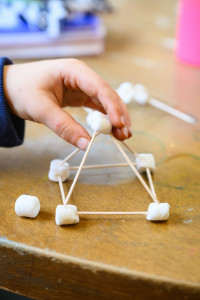Why Multi-age Learning?

In our elementary classes (ages 5-11), The Children's School at Stephens College embraces multi-age learning.
What is multi-age learning and why do we love it here at CSSC? Here's just one story of why it works so well.
From the perspective of one of our teachers:
"When I tell people about our school, the response is almost always the same: how does a multi-age classroom work? I used to provide a theoretical answer about child development and co-constructed understandings, and I stand by those commitments. But now, I find it better just to tell stories about what happens on a typical day at CSSC.
We're studying castles from all over the world and throughout time. Castles, like all of our inquiry topics, was chosen as a focus because it allows teachers and students to pull in activities and insights from the arts, history, and science and mathematics. Yesterday, older and younger students teamed up to design working drawbridges*. Without much instruction and with only a few materials, they got to work.


How does a multi-age classroom contribute to a rich engagement with material? We've noticed that drawbridges work in different ways--some pivot on an axle, some are lifted by ropes and chains, some are weighted, some are not. As students worked, they decided how they would approach their designs. Older students often report that they have to get very clear on their ideas in order to lead a small multi-age group.
Younger students contribute central ideas to multi-age groups. Sometimes, younger children find that they have good ideas but could use help executing them. Older students are excellent partners in these situations, and frequently, older students follow the lead of a younger student whose thinking may be more flexible.
The proof is in the pudding, but a multi-age classroom provides students with multiple opportunities to experiment with ideas that are theirs and others'. Students build confidence and learn to trust each other's instincts."


*The older students took a shot at defining the very slippery term castle and decided that castles usually, but don't always, include drawbridges. Here's the full definition they came up with: A fortress or mansion, usually with a drawbridge and a moat, sometimes controlled by one person, often having tight defenses.
The Children's School at Stephens College
Administrative Assistant
